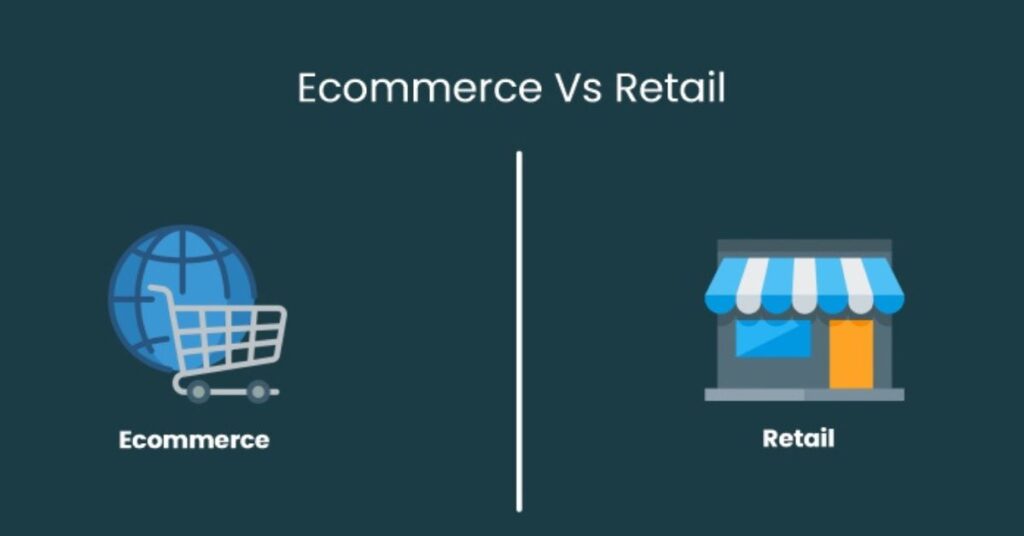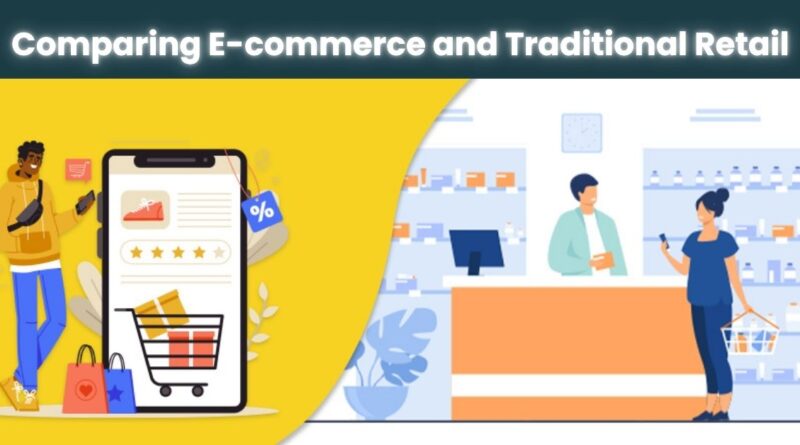Comparing E-commerce and Traditional Retail: Pros, Cons, and Future Trends
In the modern business world, commerce has evolved significantly due to technological advancements and changing consumer preferences. Two primary approaches dominate the market E-commerce and Traditional Retail. Both have unique operational models, revenue generation strategies, and customer engagement methods. While e-commerce thrives on the internet and digital tools, traditional retail operates through physical stores where customers can interact with products in person. This article explores each business model in detail, highlighting their structures, strengths, weaknesses, and how they can coexist in today’s competitive market.
Understanding E-commerce Business Models
Definition
E-commerce (Electronic Commerce) refers to the buying and selling of goods or services over the internet. It encompasses various activities such as online retail shopping, electronic payments, and digital marketing.
Types of E-commerce Models
-
B2C (Business-to-Consumer): Businesses sell directly to individual customers through websites or apps (e.g., Amazon, AliExpress).
-
B2B (Business-to-Business): Businesses sell products or services to other businesses (e.g., Alibaba, Uline).
-
C2C (Consumer-to-Consumer): Consumers sell directly to each other through platforms (e.g., eBay, Facebook Marketplace).
-
C2B (Consumer-to-Business): Individuals offer products or services to businesses (e.g., influencer partnerships).
-
D2C (Direct-to-Consumer): Brands sell directly to customers without intermediaries (e.g., Warby Parker, Glossier).
Revenue Models in E-commerce
-
Product Sales – Selling physical or digital goods.
-
Subscription Services – Offering ongoing access to products/services (e.g., Netflix, Dollar Shave Club).
-
Affiliate Marketing – Earning commissions by promoting other companies’ products.
-
Advertising Revenue – Earning from ads placed on e-commerce platforms.
Advantages of E-commerce
-
Global Reach – Businesses can target international customers.
-
Lower Operational Costs – No need for expensive physical locations.
-
Convenience – Customers can shop anytime from anywhere.
-
Data-Driven Decisions – Access to customer analytics for targeted marketing.
-
Scalability – Easy to expand product range or geographic coverage.
Disadvantages of E-commerce
-
High Competition – Global reach increases market saturation.
-
Logistics Challenges – Shipping delays and high costs for some regions.
-
Security Concerns – Risk of data breaches and cyber fraud.
-
Lack of Physical Experience – Customers cannot physically inspect items before purchase.
-
Technology Dependence – Requires reliable internet and website performance.
Understanding Traditional Retail Business Models
Definition
Traditional retail refers to physical stores where customers can browse, select, and purchase products in person. Examples include department stores, supermarkets, and boutiques.
Types of Traditional Retail Models
-
Department Stores – Large outlets with multiple product categories (e.g., Macy’s).
-
Specialty Stores – Focused on a specific category (e.g., Foot Locker).
-
Supermarkets – Food and household goods in self-service formats (e.g., Walmart).
-
Convenience Stores – Small outlets offering quick purchases (e.g., 7-Eleven).
-
Discount Stores – Lower-priced products (e.g., Dollar Tree).
-
Pop-up Shops – Temporary retail setups for events or seasonal sales.
Revenue Models in Traditional Retail
-
Direct Sales – Selling products directly to customers.
-
In-store Services – Charging for additional services like alterations or gift wrapping.
-
Brand Partnerships – Featuring exclusive collections from brands.
-
Loyalty Programs – Encouraging repeat purchases with rewards.
Advantages of Traditional Retail
-
Physical Product Experience – Customers can touch, feel, and try products.
-
Instant Gratification – Immediate product availability after purchase.
-
Face-to-Face Interaction – Personalized service and relationship building.
-
Impulse Purchases – Attractive in-store displays encourage extra purchases.
-
Trust and Familiarity – Customers may feel more confident buying from physical stores.
Disadvantages of Traditional Retail
-
High Overhead Costs – Rent, utilities, and staff salaries increase expenses.
-
Limited Reach – Restricted to local or regional markets.
-
Inventory Limitations – Space constraints limit stock availability.
-
Fixed Operating Hours – Customers must visit during store hours.
-
Impact from External Factors – Weather, location accessibility, and economic downturns affect foot traffic.
Comparative Analysis: E-commerce vs. Traditional Retail
| Aspect | E-commerce | Traditional Retail |
|---|---|---|
| Reach | Global | Local or regional |
| Customer Interaction | Digital (chat, email, video) | In-person |
| Operational Costs | Lower | Higher |
| Convenience | 24/7 availability | Limited to store hours |
| Product Experience | Images and descriptions only | Physical inspection |
| Scalability | Rapid and cost-effective | Slower and cost-intensive |
| Impulse Buying | Less frequent | More frequent |
| Logistics | Shipping required | Immediate handover |
| Data Collection | Detailed analytics | Limited data |
| Return Process | Often slower and more complex | Instant in-store returns |
Trends Shaping Both Models
For E-commerce
-
Mobile Commerce Growth – Increasing purchases via smartphones.
-
AI and Personalization – Tailored recommendations based on user behavior.
-
Social Commerce – Sales through social media platforms.
-
Augmented Reality (AR) Shopping – Virtual try-ons for clothes or furniture.
-
Sustainable E-commerce – Eco-friendly packaging and products.

For Traditional Retail
-
Experience-Centric Stores – Offering immersive brand experiences.
-
Click-and-Collect Services – Customers order online and pick up in-store.
-
Integration with Technology – Digital kiosks, self-checkout systems.
-
Community Engagement – Hosting events or workshops in stores.
-
Sustainability Initiatives – Zero-waste packaging and recycling programs.
The Hybrid Model: Omnichannel Retailing
The future of retail is not strictly e-commerce or traditional retail but a combination of both. Omnichannel retail integrates online and offline strategies, giving customers a seamless shopping experience.
Example:
A customer might browse a product online, visit a physical store to check it out, and then purchase it through the brand’s mobile app for home delivery.
Key Benefits of Omnichannel Retail:
-
Higher customer satisfaction.
-
Better brand loyalty.
-
Increased sales opportunities.
-
Flexibility for customers.
Choosing the Right Model for Your Business
When deciding between e-commerce, traditional retail, or a hybrid approach, consider:
-
Target Audience – Are they tech-savvy or prefer in-person shopping?
-
Budget – Can you afford physical store overheads?
-
Product Type – Some products require physical testing (e.g., perfumes).
-
Market Competition – Evaluate competitors’ presence in both spaces.
-
Long-term Goals – Do you aim for local dominance or global reach?
Conclusion
E-commerce and traditional retail each have distinct advantages and disadvantages. E-commerce offers convenience, scalability, and a global customer base, while traditional retail provides tangible experiences, personal service, and instant product access. The most successful modern businesses often blend the strengths of both through an omnichannel approach, ensuring they meet the evolving needs of today’s consumers.
FAQs
Q1: Which is more profitable e-commerce or traditional retail?
Profitability depends on factors such as product type, market demand, and operational efficiency. E-commerce generally has lower overheads, but traditional retail can achieve higher margins through in-person sales.
Q2: Can a small business operate both models simultaneously?
Yes, many small businesses use an omnichannel approach to maximize reach and sales.
Q3: Is e-commerce more suitable for global expansion?
Yes, e-commerce enables international sales without the need for physical stores.
Q4: How has technology impacted traditional retail?
Technology has improved efficiency through self-checkout systems, inventory management software, and digital loyalty programs.
Q5: What challenges do e-commerce businesses face most often?
Common challenges include logistics, cybersecurity threats, and high competition.




